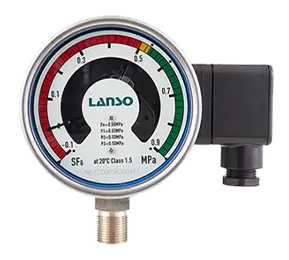The pressure gauge is for monitoring, that is, to detect the system pressure. First of all, the SF6 relay monitors the change of the system pressure, and what's more, it plays a role of control and protection. The SF6 relay can set open and close signal contacts under different pressure states. Usually there are alarm contacts and lock contacts, but pressure gauges do not have contacts. These are the differences between the two.
1. Density and purity of SF6 gas density relay
The so-called density refers to the mass per unit volume of a specific substance under specific conditions. The SF6 gas in the SF6 circuit breaker is sealed in a fixed container. It has a certain density value under the rated pressure at 20℃. It is within the range of various allowable conditions for the operation of the circuit breaker, although the pressure of SF6 gas changes with the temperature, but the density value of SF6 gas is always the same.
Because the insulation and arc extinguishing performance of SF6 circuit breakers depend to a large extent on the purity and density of SF6 gas, the detection of purity and density monitoring of SF6 gas are particularly important.
2. The role of SF6 relay
If an ordinary pressure gauge is used to monitor the leakage of SF6 gas, it will be difficult to distinguish whether the pressure change of SF6 gas is caused by the actual leakage or the change of the ambient temperature. In order to achieve the purpose of frequent monitoring of density, national standards stipulate that SF6 circuit breakers should be equipped with pressure gauges or SF6 gas density meters and SF6 relays. The pressure gauge or the SF6 gas density meter is for monitoring, and the SF6 relay is for control and protection.
The SF6 gas density relay calibrator is an instrument specially used to calibrate various forms of SF6 gas density relays. Its main function is to measure the pressure value of SF6 gas density relay in contact action, and according to the SF6 gas pressure value and temperature value locked by SF6 gas density relay calibrator in the instantaneous contact action, automatically convert it to the standard pressure value corresponding to 20℃.
Measurement performance requirements:
(1) Pressure indication error
The expression of allowable error of pressure indication Δy is: Δy=±a%F·S
a——Accuracy grade of the inspected instrument (according to the regulations of the product technical manual) F·S——The pressure range of the inspected instrument
(2) Pressure return error
The pressure return error should not be greater than the absolute value of the allowable error of the pressure indication.
(3) Temperature measurement error
The temperature measurement error should not exceed ±0.05℃.
(4) P20 indication error
The P20 indication error displayed by the inspected instrument should not exceed the allowable error of the pressure indication. Note: P20 value refers to the pressure value of SF6 gas at 20°C under the condition of constant SF6 gas density.
(5) P20 conversion error
The conversion error of the tested instrument to the P20 value should not exceed 1/2 of the allowable error of the pressure indication.
Note: P20 conversion error refers to the difference between the P20 value displayed on the inspected instrument and the P20 value calculated by the standard device based on the pressure value and temperature value of the inspected instrument.
Related Article for Reference
Types of Pressure Measuring Instrument
The types of pressure measuring instruments are divided into liquid column type, elastic type and electric measuring type according to the working principle. The pressure gauge can indicate and record...
Tue 12 2020
Test Instructions of SF6 Gas Density Relay Calibrator
The SF6 gas density relay calibrator is suitable for the detection of the SF6 gas density relay in power supply enterprises, high-voltage switch factories, infrastructure installations, scientific res...
Wed 01 2022
Installation and Use of Precision Pressure Gauges
Ⅰ. Usage description of precision pressure gauge:Precision pressure gauges are mainly used to calibrate common industrial pressure gauges, and can also accurately measure the pressure of non-corrosiv...
Thu 04 2021







